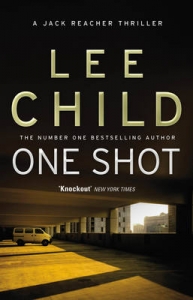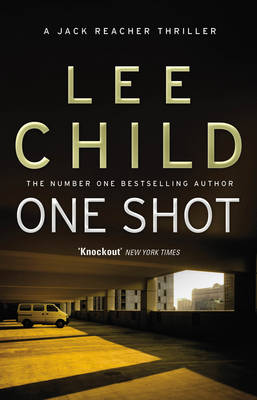
Now filmed as the blockbuster movie 'Jack Reacher', starring Tom Cruise. Six shots. Five dead. A heartland city thrown into terror. But within hours the cops have it solved. A slam-dunk case. Apart from one thing. The accused gunman refuses to talk except for a single phrase: Get Jack Reacher for me. Reacher lives off the grid. He's not looking for trouble. But sometimes trouble looks for him. What could connect the ex-military cop to this psychopathic killer?
ONE
Friday. Five o’clock in the afternoon. Maybe the hardest time to move unobserved through a city. Or, maybe the easiest. Because at five o’clock on a Friday nobody pays attention to anything. Except the road ahead.
The man with the rifle drove north. Not fast, not slow. Not drawing attention. Not standing out. He was in a light-coloured minivan that had seen better days. He was alone behind the wheel. He was wearing a light-coloured raincoat and the kind of shapeless light-coloured beanie hat that old guys wear on the golf course when the sun is out or the rain is falling. The hat had a two-tone red band all round it. It was pulled down low. The coat was buttoned up high. The man was wearing sunglasses, even though the van had dark windows and the sky was cloudy. And he was wearing gloves, even though winter was three months away and the weather wasn’t cold.
Traffic slowed to a crawl where First Street started up a hill. Then it stopped completely where two lanes became one because the blacktop was torn up for construction. There was construction all over town. Driving had been a nightmare for a year. Holes in the road, gravel trucks, concrete trucks, blacktop spreaders. The man with the rifle lifted his hand off the wheel. Pulled back his cuff. Checked his watch.
Eleven minutes.
Be patient.
He took his foot off the brake and crawled ahead. Then he stopped again where the roadway narrowed and the sidewalks widened where the downtown shopping district started. There were big stores to the left and the right, each one set a little higher than the last, because of the hill. The wide sidewalks gave plenty of space for shoppers to stroll. There were cast-iron flag poles and castiron lamp posts all lined up like sentries between the people and the cars. The people had more space than the cars. Traffic was very slow. He checked his watch again.
Eight minutes.
Be patient.
A hundred yards later the prosperity faded a little. The congestion eased. First Street opened out and became slightly shabby again. There were bars and dollar stores. Then a parking garage on the left. Then yet more construction, where the parking garage was being extended. Then further ahead the street was blocked by a low wall. Behind it was a windy pedestrian plaza with an ornamental pool and a fountain. On the plaza’s left, the old city library. On its right, a new office building. Behind it, a black glass tower. First Street turned an abrupt right angle in front of the plaza’s boundary wall and ran away west, past untidy rear entrances and loading docks and then on under the raised state highway.
But the man in the minivan slowed before he hit the turn in front of the plaza and made a left and entered the parking garage. He drove straight up the ramp. There was no barrier, because each space had its own parking meter. Therefore there was no cashier, no witness, no ticket, no paper trail. The man in the minivan knew all that. He wound round the ramps to the second level and headed for the far back corner of the structure. Left the van idling in the aisle for a moment and slipped out of the seat and moved an orange traffic cone from the space he wanted. It was the last one in the old part of the building, right next to where the new part was being added on.
“He opened the minivan’s sliding rear door and leaned inside and unfolded a blanket and revealed the rifle.”
He drove the van into the space and shut it down. Sat still for a moment. The garage was quiet. It was completely full with silent cars. The space he had protected with the traffic cone had been the last one available. The garage was always packed. He knew that. That was why they were extending it. They were doubling its size. It was used by shoppers. That was why it was quiet. Nobody in their right mind would try to leave at five o’clock. Not into the rush hour traffic. Not with the construction delays. Either they would get out by four or wait until six.
The man in the minivan checked his watch.
Four minutes.
Easy.
He opened the driver’s door and slid out. Took a quarter from his pocket and put it in the meter. Twisted the handle hard and heard the coin fall and saw the clockwork give him an hour in exchange. There was no other sound. Nothing in the air except the smell of parked automobiles. Gasoline, rubber, cold exhaust.
He stood still next to the van. On his feet he had a pair of old desert boots. Khaki suede, single eyelets, white crepe soles, made by Clarks of England, much favoured by Special Forces soldiers. An iconic design, unchanged in maybe sixty years.
He glanced back at the parking meter. Fifty-nine minutes. He wouldn’t need fifty-nine minutes. He opened the minivan’s sliding rear door and leaned inside and unfolded a blanket and revealed the rifle. It was a Springfield M1A Super Match autoloader, American walnut stock, heavy premium barrel, ten shot box magazine, chambered for the .308. It was the exact commercial equivalent of the M14 self-loading sniper rifle that the American military had used during his long-ago years in the service. It was a fine weapon. Maybe not quite as accurate with the first cold shot as a top-of-the-line bolt gun, but it would do. It would do just fine. He wasn’t going to be looking at extraordinary distances. It was loaded with Lake City M852s. His favourite custom cartridges. Special Lake City Match brass, Federal powder, Sierra Matchking 168-grain hollow point boat tail bullets. The load was better than the gun, probably. A slight mismatch.
He listened to the silence and lifted the rifle off the rear bench. Carried it away with him to where the old part of the garage finished and the new part began. There was a half-inch trench between the old concrete and the new. Like a demarcation line. He guessed it was an expansion joint. For the summer heat. He guessed they were going to fill it with soft tar. Directly above it there was yellow and black Caution Do Not Enter tape strung between two pillars. He dropped to one knee and slid under it. Stood up again and walked on into the raw new construction.
Parts of the new concrete floor were trowelled smooth and parts were rough, still waiting for a final surface. There were wooden planks laid here and there as walkways. There were haphazard piles of paper cement sacks, some full, some empty. There were more open expansion joints. There were strings of bare light bulbs, turned off. Empty wheelbarrows, crushed soda cans, spools of cable, unexplained lengths of lumber, piles of crushed stone, silent concrete mixers. There was grey cement dust everywhere, as fine as talc, and the smell of damp lime.
“The low crawl was a sniper’s principal mode of movement. In his years in the service he had low crawled a million miles.”
The man with the rifle walked on in the darkness until he came close to the new northeast corner. Then he stopped and put his back tight against a raw concrete pillar and stood still. Inched to his right with his head turned until he could see where he was. He was about eight feet from the garage’s new perimeter wall. Looking due north. The wall was about waist-high. It was unfinished. It had bolts cast into it to take lengths of metal barrier to stop cars hitting the concrete. There were receptacles cast into the floor to take the new parking meter posts.
The man with the rifle inched forward and turned a little until he felt the corner of the pillar between his shoulder blades. He turned his head again. Now he was looking north and east. Directly into the public plaza. The ornamental pool was a long narrow rectangle running away from him. It was maybe eighty feet by twenty. It was like a large tank of water, just sitting there. Like a big above-ground lap pool. It was bounded by four waist-high brick walls. The water lapped against their inner faces. His line of sight ran on an exact diagonal from its near front corner to its far back corner. The water looked to be about three feet deep. The fountain splashed right in the centre of the pool. He could hear it, and he could hear slow traffic on the street, and the shuffle of feet below him. The front wall of the pool was about three feet behind the wall that separated the plaza from First Street. The two low walls ran close together and parallel for twenty feet, east to west, with just the width of a narrow walkway between them.
He was on the garage’s second level but the way First Street ran uphill meant the plaza was much less than one storey below him. There was a definite downward angle, but it was shallow. On the right of the plaza he could see the new office building’s door. It was a shabby place. It had been built and it hadn’t rented. He knew that. So to preserve some kind of credibility for the new downtown the state had filled it with government offices. The Department of Motor Vehicles was in there, and a joint Army–Navy–Air Force–Marine Corps recruiting office. Maybe Social Security was in there. Maybe the Internal Revenue Service. The man with the rifle wasn’t really sure. And he didn’t really care.
He dropped to his knees and then to his stomach. The low crawl was a sniper’s principal mode of movement. In his years in the service he had low crawled a million miles. Knees and elbows and belly. Standard tactical doctrine was for the sniper and his spotter to detach from the company a thousand yards out and crawl into position. In training he had sometimes taken many hours to do it, to avoid the observer’s binoculars. But this time he had only eight feet to cover. And as far as he knew there were no binoculars on him.
He reached the base of the wall and lay flat on the ground, pressed up tight against the raw concrete. Then he squirmed up into a sitting position. Then he knelt. He folded his right leg tight underneath him. He planted his left foot flat and his left shin vertical. He propped his left elbow on his left knee. Raised the rifle. Rested the end of the forestock on the top of the low concrete wall. Sawed it gently back and forth until it felt good and solid. Supported kneeling, the training manual called it. It was a good position. Second only to lying prone with a bipod, in his experience. He breathed in, breathed out. One shot, one kill. That was the sniper’s credo. To succeed required control and stillness and calm. He breathed in, breathed out. Felt himself relax. Felt himself come home.
Ready.
Infiltration successful.
Now wait until the time is right.
Extracted from One Shot by Lee Child, out now.









